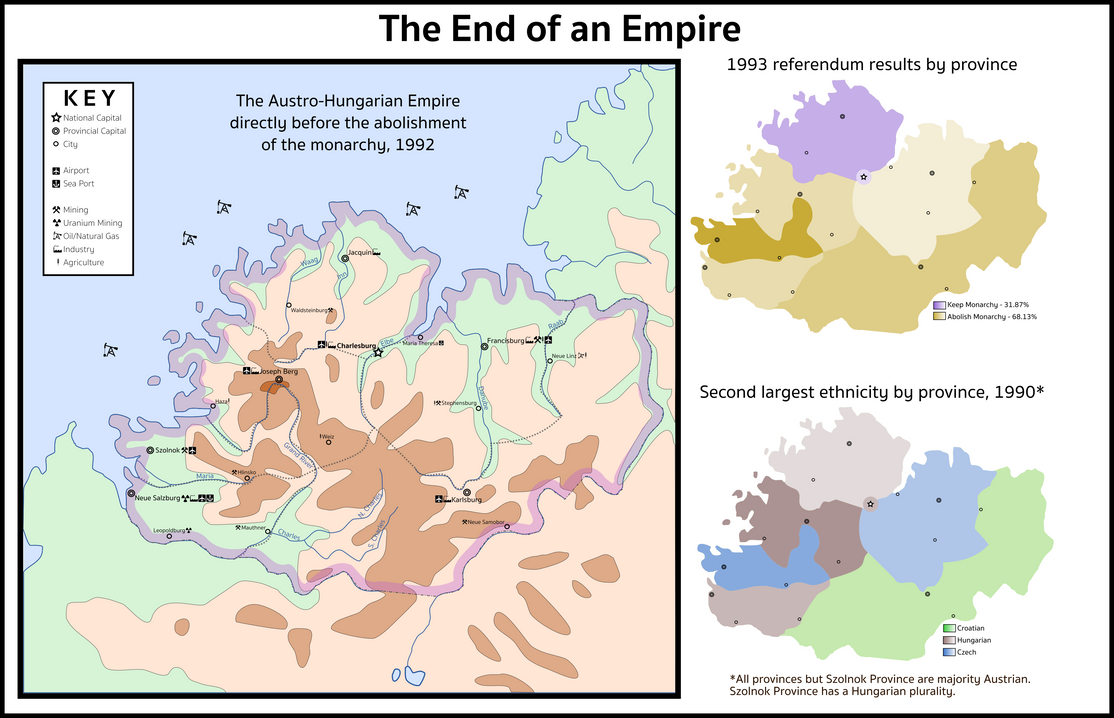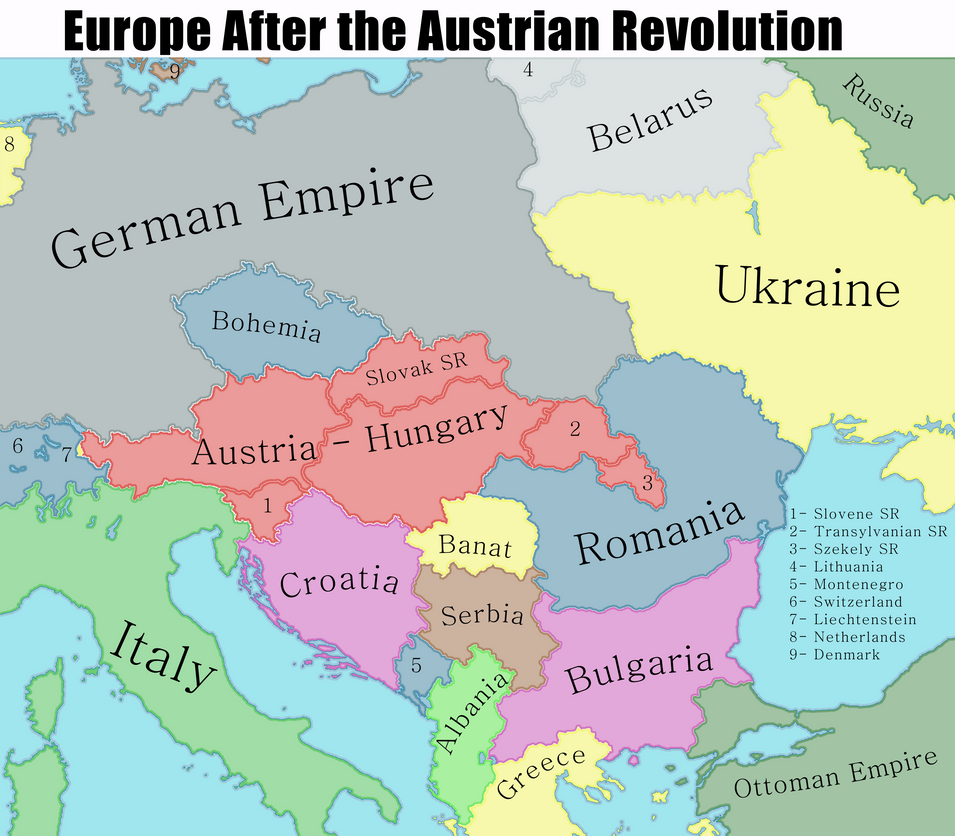The Imperial Hexarchy of Danube
Brief history of the Imperial Hexarchy of Danube
Since the death of Franz Joseph I in 1916, Franz Ferdinand I was crowned 'Emperor and King' and started a process of reforms againt the 'Little Compromise' of 1867.
Despite the opposition of Magiar nobility, he met with representant of other nationalities of the Empire. Finally, in 1917 was signed 'the Wide Compromise', Franz Ferdinand I reformulated the state(s): Six Kingdoms, two with Constitutional rank (Austria and Hungary) and four with Autonomous rank (Cheko - Eslovakia, Galitzia, Transilvania and Yugo-Eslavia), and five Autonomous Territories (Silesia, Sudetes, Eastern Transilvania, Trento, and Trieste and fiume). With the support of non-magiar minorities, principally of Romanian and Polish, he broken the Hungarian opposition and forced them to accept the new Compromise.
In 1921, after a failed attempt of assessination, made the first ''addendum'': the 'Law about the Imperial House'. In this regulation, his son (born in a morganatic marriage) was allowed be promote at throne. In this case, the opposition was leaded by Karl, his heir presuntive. However, the proposal was sucefull and the son of Franz Ferdinand was proclaimed 'Archiduke' and 'Crown Heir'.
During the 'Crisis of the 20s', caused by the crack of 1925 and the Russian Revolution (1927), the Compromise was reformated again: the Imperial Ministry of Social Development was created, 'Imperial Declaration about the Wrights of Peoples and the Citizen' was santioned, and the deputy to Imperial Diet passed to be choissen by the people of each Kingdoms and Territories. Also was created the Counsil of the Kingdoms and Territories, and the Supreme Court of Constitutional Justice.
This crisis afected the political parties sistem, and several new agrupation arose in this age, specially comunist and authoritarian nationalist grups.
In the decade of 50, Maximilian Franz I established the Imperial Council of State, the 'Carte about Constitucional Action' and the 'Law about Constitutional Distric Courts in the Kingdoms and Territories'.
The last ''addendum'' to the Compromise allowed the daugther of the Emperor to be heir of him, in equal condition of a male.
Government:
The Emperor, unlike another constitutional monarchy, has some faculties and power. He proposed the judges and Imperial Courts to the Imperial Diet, as like the Ombusdman of the Peolples of the Empire, the President of the Central Bank of the Empier, etc.
The Gabinet of the Empire is composed of five ministres: the Chief of the Imperial Gabinet, the Ministre of Foreing Relations, the Ministre of Economy and Finances, the Ministre of Defense and the Ministre of Social Development. They must be apoved, and can be removed, by the Diet.
The governments of all Kingdoms and Territories make up the Counsil of the Kingdoms and Territories. They send a delegation whem must deal with theire affairs and the delegation must vote unanimously. Each Constitutional Kingdom has 15 votes, each Autonomous Kingdom has 7 votes, and each Autonomous Territories has 3.
In each Kingdom or Territory, the Emperor appoint a person as 'Imperial Lieutenant', the representant of the Emperor in this place. He/she can be of any nationality of the Empire, except in the Constitutional Kingdoms, in wich case must be national or long time residence of this (except for member of the Imperial House).
Political Parties:
The Imperial Hexarchy of Danube is a democracy. The two principal parties are the Party of Workers and Countrymen (PWC; socialdemocracy) and the Party of the Union and the Convergence (PUC; liberalism [in the european means]).
Another important parties are the Party of Christian Democracy (PCD) and the Party Magiar Dignity (PMD; ethnic, wright wind)
Various ethnic in the Empire has their own party, generally minority: Party Our House (polish), Party Moravian Legacy (PML), National Party of Transilvania (NPT), etc. There are a confesional muslim party in Bosnia: the Party of God's Comunity (PGD); a ecologist one, the Party House Earth (PHE), and even a feminist Party of Female Freed (PFF).
Just out of curiosity:
According a friend of Franz Ferdindand I, he said "I prefer establish the Republic, before see my nephew in the throne".
In this temporal line (aka FSTL), World War I do not happen, neither the defeat of German Empire, neither the Treaty of Versailles. Intead, in 1925 happened the crack in New York, the world economical crisis and the Russian Revolution of 1927.... but this is another story.
In FSTL, Adolf Hitler was a failed artist, one of the founder and leader of the Party for the Laborious People during the decades of 20 and 30. This party, originally german ethnic, xenophobe and antisemitic, is now democratic, but still xenophobe.
The first Chairman of the Supreme Court of Constitutional Justice, and one of the sponsor of it, was Hans Kelsen.
The Ernest Mach Institute organized a competition to create a 'perfect scientific and intercultural language', to use in the Imperial Administration and across the Empires. The award has not winner still.
In FSTL,
Vladimir Franz is Chairman of the Supreme Court of Constitutional Justice, and
Milan Babić is the Ombusdman of the Peoples... strange, rare, if-world, not?
PS:
I used this resource:
For the flag:
https://commons.wikimedia.org/wiki/File:Imperial_Standard_of_Austria_(1828-Late_19th_Century).svg
For the map:
https://commons.wikimedia.org/wiki/File:Austria_Hungary_ethnic_ES.svg
and edited with Corel Draw and Photoshop
Finally, remember that english is not my mother tongue; sure there are several mistake... let's be acquiescent






